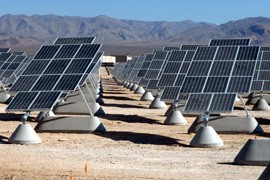Cronkite News has moved to a new home at cronkitenews.azpbs.org. Use this site to search archives from 2011 to May 2015. You can search the new site for current stories.
BLM sets aside 21,000 acres near Yuma for possible solar project
WASHINGTON – The Bureau of Land Management on Monday put aside nearly 21,000 acres of public land near Yuma for the next two years while it studies its potential for use as a solar energy site.
The agency said Monday that the “segregation” of land in Agua Caliente protects the area from mining claims and other prospective uses as the bureau analyzes its potential.
“We’re trying to identify the best places to develop renewable energy,” said Lane Cowger, BLM deputy project manager in Arizona. “There’s real potential we think in the Agua Caliente site.”
It is part of a statewide effort by the agency to identify public lands that could be used for renewable energy.The Restoration Design Energy Project looks at lands previously used for mines, landfills and agriculture as well as places where solar energy developments would not cause conflict.
“This is the BLM being proactive in identifying the best areas and development practices for renewable energy in Arizona,” Cowger said. “These are areas that don’t have resources that we are specifically managing for and protecting.”
While the Department of the Interior has mounted a national effort to identify potential “solar energy zones,” the BLM move to identify sites in one state is unique and could serve as a national model, supporters say.
“Arizona is the only place where this is being done,” said Amanda Ormond, a director of the Western Grid Group, which advocates for clean energy for Western states. “There is talk that if this is successful maybe they can expand this to other states.”
Arizona BLM leaders took the initiative to pursue this project and secure money for it, said Dennis Godfrey, an agency spokesman.
“It certainly has the attention of our national office and people are interested in it,” Godfrey said. “It’s kind of a grassroots-up operation up rather than top-down, coming from Washington.”
The move was welcomed by the solar industry and environmentalists.
The American Solar Energy Society said the segregation follows up on President Barack Obama’s call to open up more public lands to clean-energy use. Society spokesman Seth Masia said it makes the whole process easier for solar energy companies.
“It makes a whole lot more sense for the government to go ahead early and figure out which tracts are in fact economically and environmentally sensible for development and then open those up for companies,” Masia said.
Cowger said the Agua Caliente site is located near an existing transmission line that has capacity to carry power produced there. Masia said that is “critical because transmission lines are very expensive to build and there’s often local opposition to build more transmission lines.”
Environmental groups said it makes sense for the BLM to look at its land in order to head off conflicts.
“It’s great to avoid the conflict upfront,” said Kevin Dahl, Arizona program manager for the National Parks Conservation Association. “Companies would much rather do their stuff in areas where they’re not likely to face a lot of conflict.”
Finding lands no longer used for other activities that could be used for solar energy “is an example of great land-use planning, in my humble opinion,” Dahl said.
Sandy Bahr, of the Sierra Club Grand Canyon Chapter, said her group supports the BLM doing its homework to find appropriate lands and avoid conflict with “companies who come in and say, ‘We want to put something here.’”
“It’s better to have the land managers really looking at the issues and looking at the land and looking at any potential conflicts upfront,” she said. “Doing this kind of work up front makes a lot of sense.”







